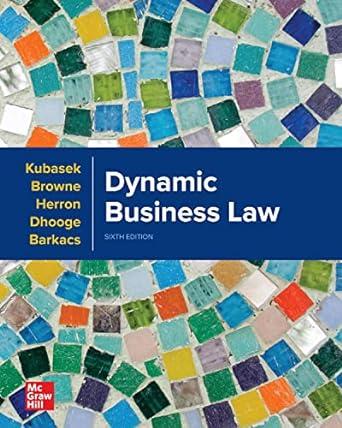In 2016, a hacker tricked a Lamps Plus employee into disclosing the tax information of approximately 1,300
Question:
In 2016, a hacker tricked a Lamps Plus employee into disclosing the tax information of approximately 1,300 other employees, resulting in the filing of a fraudulent income tax return of Lamps Plus employee Frank Varela. Varela filed a putative class action suit against Lamps Plus in Federal District Court in California, despite having signed an arbitration agreement with his employer. Ultimately, the district court granted Lamps Plus’s motion to compel arbitration but rejected its request for individual arbitration and ordered arbitration on a class-wide basis. The Ninth Circuit affirmed on appeal, finding that the employment agreement was ambiguous on the issue of whether class arbitration was acceptable, and California law construes contractual ambiguities against the drafter, meaning the clause would be construed against Lamps Plus and classwide arbitration was ordered. Lamps Plus appealed, claiming that the court erred in compelling classwide arbitration. CHIEF JUSTICE ROBERTS We therefore face the question whether, consistent with the FAA, an ambiguous agreement can provide the necessary “contractual basis” for compelling class arbitration. … We hold that it cannot—a conclusion that follows directly from our decision in Stolt-Nielsen. Class arbitration is not only markedly different from the “traditional individualized arbitration” contemplated by the FAA, it also undermines the most important benefits of that familiar form of arbitration. … The statute therefore requires more than ambiguity to ensure that the parties agreed to arbitrate on a classwide basis.
The FAA requires courts to “enforce arbitration agreements according to their terms.” Although courts may ordinarily accomplish that end by relying on state contract principles, state law is preempted to the extent it “stands as an obstacle to the accomplishment and execution of the full purposes and objectives” of the FAA. At issue in this case is the interaction between a state contract principle for addressing ambiguity and a “rule of fundamental importance” under the FAA, namely, that arbitration “is a matter of consent, not coercion.”
[T]he first principle that underscores all of our arbitration decisions is that “[a]rbitration is strictly a matter of consent … Consent is essential under the FAA because arbitrators wield only the authority they are given. That is, they derive their “powers from the parties’ agreement to forgo the legal process and submit their disputes to private dispute resolution.” …Whatever they settle on, the task for courts and arbitrators at bottom remains the same: “to give effect to the intent of the parties.”
In carrying out that responsibility it is important to recognize the “fundamental” difference between class arbitration and the individualized form of arbitration envisioned by the FAA. In individual arbitration, “parties forgo the procedural rigor and appellate review of the courts in order to realize the benefits of private dispute resolution: lower costs, greater efficiency and speed, and the ability to choose expert adjudicators to resolve specialized disputes.” Class arbitration lacks those benefits. It “sacrifices the principal advantage of arbitration—its informality—and makes the process slower, more costly, and more likely to generate procedural morass than final judgment.” … Class arbitration not only “introduce[s] new risks and costs for both sides,” it also raises serious due process concerns by adjudicating the rights of absent members of the plaintiff class—again, with only limited judicial review.
Because of these “crucial differences” between individual and class arbitration, Stolt-Nielsen explained that there is “reason to doubt the parties’ mutual consent to resolve disputes through classwide arbitration.” And for that reason, we held that courts may not infer consent to participate in class arbitration absent an affirmative “contractual basis for concluding that the party agreed to do so. Silence is not enough; the “FAA requires more.”
Our reasoning in Stolt-Nielsen controls the question we face today. Like silence, ambiguity does not provide a sufficient basis to conclude that parties to an arbitration agreement agreed to “sacrifice the principal advantage of arbitration.”
class arbitration, to the extent it is manufactured by [state law] rather than consent, is inconsistent with the FAA.”
CRITICAL THINKING:
What ambiguity can be seen as playing a significant role in the court’s decision?
ETHICAL DECISION MAKING:
This case was decided by a 5–4 vote, with the dissenters who agreed with the reasoning of the district court. Those who disagreed with the majority clearly placed a higher value on the interests of a different group of stakeholders than those prioritized by the majority. Explain which stakeholders are helped most by this decision and which are harmed.
Step by Step Answer:

Dynamic Business Law
ISBN: 9781260733976
6th Edition
Authors: Nancy Kubasek, M. Neil Browne, Daniel Herron, Lucien Dhooge, Linda Barkacs





